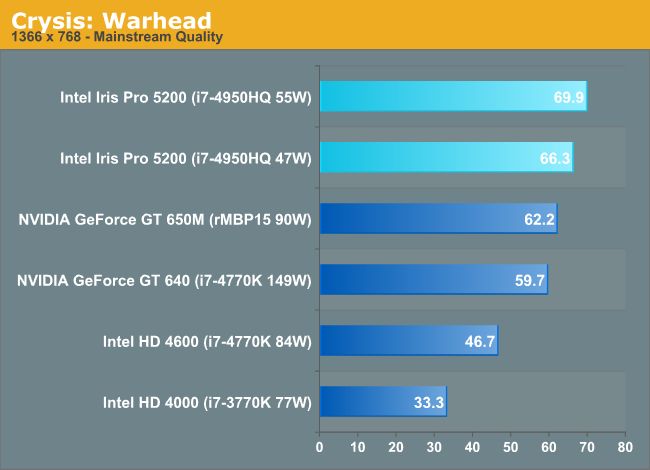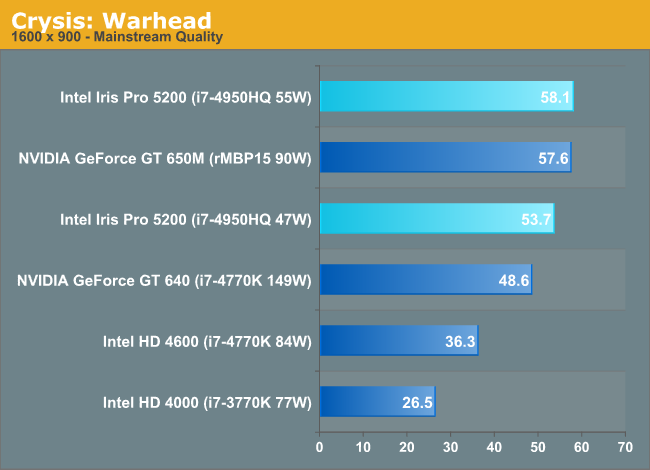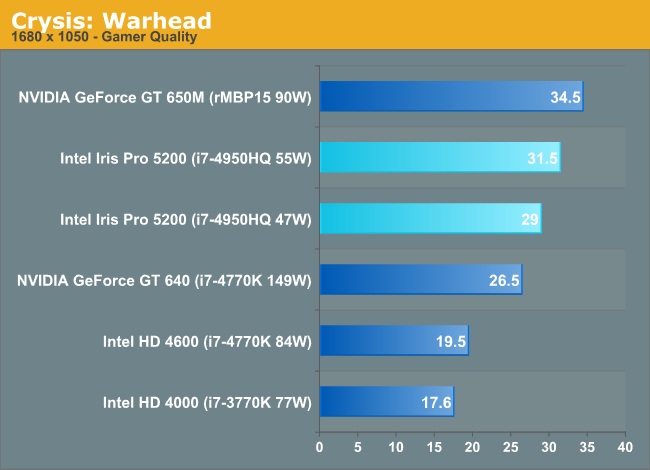Intel Iris Pro 5200 Graphics Review: Core i7-4950HQ Tested
by Anand Lal Shimpi on June 1, 2013 10:01 AM ESTCrysis Warhead
Up next is our legacy title for 2013, Crysis: Warhead. The stand-alone expansion to 2007’s Crysis, at over 4 years old Crysis: Warhead can still beat most systems down. Crysis was intended to be future-looking as far as performance and visual quality goes, and it has clearly achieved that. We’ve only finally reached the point where high-end single-GPU cards have come out that can hit 60fps at 1920 with 4xAA, while low-end GPUs are just now hitting 60fps at lower quality settings and resolutions.

I can't believe it. An Intel integrated solution actually beats out an NVIDIA discrete GPU in a Crysis title. The 5200 does well here, outperforming the 650M by 12% in its highest TDP configuration. I couldn't run any of the AMD parts here as Bulldozer based parts seem to have a problem with our Crysis benchmark for some reason.
Crysis: Warhead is likely one of the simpler tests we have in our suite here, which helps explain Intel's performance a bit. It's also possible that older titles have been Intel optimization targets for longer.

Ramping up the res kills the gap between the highest end Iris Pro and the GT 650M.

Moving to higher settings and at a higher resolution gives NVIDIA the win once more. The margin of victory isn't huge, but the added special effects definitely stress whatever Intel is lacking within its GPU architecture.










177 Comments
View All Comments
virgult - Saturday, August 31, 2013 - link
Nvidia Kepler plays Crysis 3 well but it sucks insanely hard at computing and rendering.Eric S - Wednesday, July 3, 2013 - link
It appears to do compute better then graphics (and ECC memory is a plus for compute). That is exactly what pros will be looking for. Apple doesn't cater to the gaming market with these machines even if they should play most games fine. A dedicated gaming machine would be built much different then this.jasonelmore - Sunday, June 2, 2013 - link
This, I dont know about anyone else, but i'm not dropping 2 grand or $2700 with upgrades on a 15 incher that does not have dedicated graphics.Another problem i see is the 13" Retina only uses duals, and if they did use this quad with GT3e silicon, then the price of of the 13" will go up at least $150 since the i7's and i5's the 13" currently use, are sub $300 parts.
The only solution i see is Apple offering it as a build to order/max upgrade option, and even then they risk segmentation across the product line.
fteoath64 - Monday, June 3, 2013 - link
"can't sell a $2000 laptop without a dedicated GFX". Absolutely true, especially when the GT3e is still a little slower than the 650M. So the 750M tweaked a few mhz higher will do nicely for the rMBP. The 13 incher will get a boost with the GT3e CPU. So a slight upgrade to lower power cpu maybe worthwhile to some. Improvement to 1080p eyesight camera would be a given for the new rMBP.Eric S - Wednesday, July 3, 2013 - link
You can drop discrete graphics when that $2000+ laptop is using builtin graphics with the same price premium and number of transistors of the discrete chip. I'm almost positive the discrete will go away. I have a feeling that Apple had a say in optimizations and stressed OpenCL performance. That is probably what they will highlight when they announce a new MacBook Pro.xtc-604 - Saturday, June 8, 2013 - link
I really hope that Apple continues to treat the rMBP 15 as a flagship. Giving it iGPU only would be a deal breaker for many professionals. Atleast in haswell's current form. Until Intel can make an IGPU that atleast matches or exceeds performance at high resolutions, it is still a no go for me.Eric S - Wednesday, July 3, 2013 - link
Why is that a deal breaker? The Iris 5200 is better then a discrete chip for compute (OpenCL). If you are doing 3D rendering, video editing, photoshop, bioinformatics, etc. that is what you should care about. It also has ECC memory unlike a discrete chip so you know your output is correct. How fast it can texture triangles is less important. It still has plenty of power in that area for any pro app. This is not designed to be a gaming machine. Not sure why anyone would be surprised it may not be optimized for that.Eric S - Monday, July 1, 2013 - link
You never know, but I doubt it. They will have trouble with the ports on the side if they make it smaller. I think it is more likely the space saving will go to additional battery. They may be able to get similar battery life increases to the Air with the extra space.mikeztm - Tuesday, June 4, 2013 - link
Notice that the 13" 2012 rMBP is a little thicker than the 15" version. Quad core in 13 inch may be planned at the very beginning.axien86 - Saturday, June 1, 2013 - link
Look at the overheating issues that come with i5/i7 Razer notebooks and finding the same heating noticed in their Haswell notebook press event several days ago.
If Apple decides to use these Haswells which put out heat in a concentrated area and in very thin outlines, you are essentially computing over a mini-bake oven.